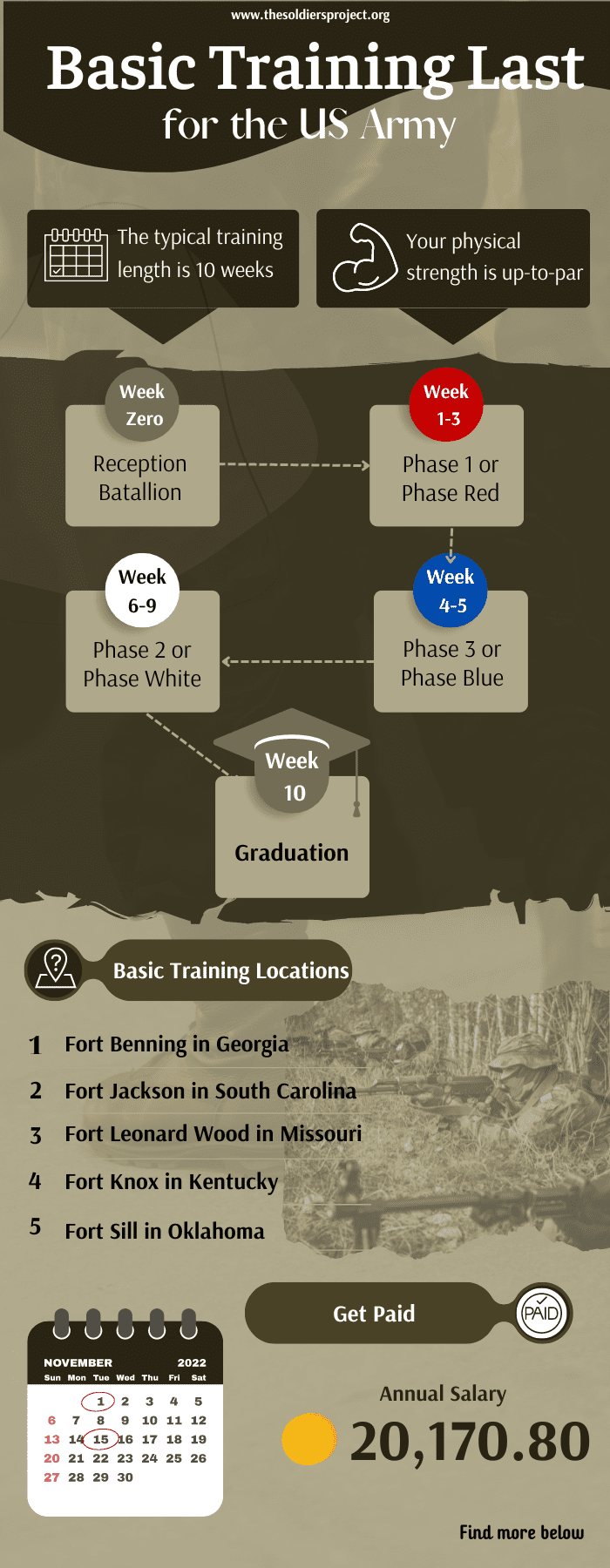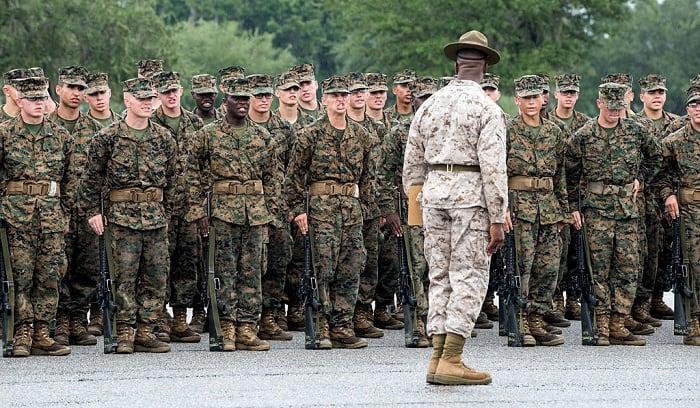We get a lot of queries from soon-to-be soldiers about Army basic training. It’s not too much of a surprise since this is one of the first steps that any soldier must take to enter the force. Today, we will address a series of those queries.
Continue reading to find everything you need to know about basic training in the Army!
Table of Contents
How Long Is Army Basic Training?
The typical Army basic training length is 10 weeks. But it can vary slightly depending on your specific military occupational specialty (MOS). After basic training, you will also have to commit to 2 Advanced Individual Training (AIT) phases, ranging from 4 weeks to a year.
What Are the Prerequisite Requirements?
In order to head into basic training, you need to pass the Reception Battalion standards, which ensure that your physical strength is up-to-par. If you do not meet the standards, you will have to await more instructions from the fitness training company.
What Does Army Basic Training Include?
Basic combat training, also commonly referred to as boot camp, is divided into phases. In detail, there will be:
- Week Zero – Reception Batallion
- Weeks 1 to 3 – Phase 1 or Phase Red
- Weeks 4 and 5 – Phase 2 or Phase White
- Weeks 6 to 9 – Phase 3 or Phase Blue
- Week 10 – Graduation
1. Week Zero — Reception Batallion
This week is primarily reserved for in-processings. So, lots and lots of paperwork. It is also the time for you to make a good first impression. You will take your first (PT) Physical Training test!
Other than that, here is what your week may look like:
Day 1
- You receive your ID card at the Pay Station
- You receive your Smart card for expenses (These are deducted from the first month’s pay)
- You will receive your uniforms and TA-50 field gear at the Central Issuing Facility: You will also turn in your civilian clothes
- You will take a medical exam, which includes a blood test: Females will take a blood test for pregnancy on the first day and a regular test on the second day
- You will be briefed on the information of the Servicemembers Group Life Insurance, GI Bill, and the Reserve Component
- You will go through a “Moment of Truth” briefing, which is your last chance to disclose any remaining unaddressed obligations
- You will be introduced to Army basics at the General Orientation station. This includes the Red Cross, Uniform Code of Military Justice, chaplain’s role, company policies, and personal affairs management
- You can purchase anything you need but do not already have at the Post Exchange, such as appropriate running shoes
Day 2
- You will get 6 vaccine shots for the measles, mumps, diphtheria, rubella, flucillin, and smallpox
- You will have a vision checkup and a dental exam, including an X-ray. You will receive a protective mouth guard to be used in certain training exercises as well
- You will drop by the Personal Affairs Division to review and verify that all of your affairs are complete and resolved
Day 3
- You will be issued two glasses and insert lenses if you need them. They will be made on site
- You will take a photo in your military uniform for the yearbook, video, and graduation ring. You can purchase the yearbook, video, or graduation ring in advance, too
Day 4
- You make sure that all your processings are complete
- You will get your assigned unit and ship
Day 5
- You will clean your barracks
- You will label all your bags with your ID tags
- Finally, you will ship to your assigned unit
2. Weeks 1 to 3 — Phase 1 or Phase Red
These are the weeks you learn the fundamentals of being a soldier. By the end of this first phase, you should know how to:
- quote the Warrior Ethos and Soldier’s Creed
- brief through basic first aid
- be aware of sexual harassment and relevant prevention programs
- perform as expected in road marches and formation marches
- use breathing masks properly (as part of the introduction to Chemical Radioactive Biological and Nuclear Readiness – CBRN)
Ultimately, you will be given an Army Unit Patch to be worn on your left shoulder.
3. Weeks 4 and 5 — Phase 2 or Phase White
In this phase, you will concentrate on combat skills, which involve technical know-how and soft supplements like teamwork and self-discipline. You will be assigned a primary weapon to begin learning the basics of rifle marksmanship. During hand-to-hand training, you will know how to engage targets at different distances and prioritize multiple targets simultaneously.
Navigating obstacle courses and abseiling from a structure called the Warrior Tower, which is 50 feet tall, is also a part of this phase. Towards the end, you will be introduced to battle drills and Warrior tasks, which makes the bulk of the next phase.
This is the “real” final phase of your basic training in the military, in which you will essentially be building on everything that you have learned. This includes advancing in:
- marksmanship and maneuvering skills
- target engagement (as a team)
- convoy operations
- weapon handling
- identifying and disabling explosive devices
You will have to prove your accumulated skills in a multiple-day land navigation course and a test with 212 end-of-cycle tasks. If you qualify, you will be entitled to an Army Black Beret.
4. Week 10 – Graduation
Just like a high school or college graduation, you will graduate from basic combat training and become an official soldier. Aside from the graduation ceremony itself, there will be inspections, out-processings, and family day, among other things. You can give yourself a pat on the back and ready yourself for a career in the Army.
Where Does the Basic Training Take Place?
There are five basic training locations.
- Fort Benning in Georgia
- Fort Jackson in South Carolina
- Fort Leonard Wood in Missouri
- Fort Knox in Kentucky
- Fort Sill in Oklahoma
Where you go for basic training depends on your chosen specialty.
If you identify as a woman, you will likely be going to Fort Jackson, Fort Leonard Wood, or Fort Sill, where training is gender-integrated training.
Do I Get Paid?
Yes! You will get paid while you are at basic training, and you will be paid twice every month. So, on the 1st and the 15th. How much you receive is established during the in-processings of Week 0.
Note: If you arrive at basic training after the 10th, you won’t get paid until next month’s 1st. But, it will still include all the pay you are entitled to.
It will depend on your rank. Most recruits start as an E1, whose annual salary is $20,170.80, and since basic training is about 10 weeks, you can expect a pay of roughly $3,800. But keep in mind that you will already be given meals and housing.
You may also receive a monthly housing allowance and separation days allowance if you have dependents. The specifics will vary depending on where your dependents are and how long you’ve been separated.
Conclusion
Now, you know that the answer to, “How long does basic training last for the US army” is ~10 weeks. Along with other relevant information on the Army’s basic training, you know what to expect when you head into basic training yourself. Hopefully, you have found this helpful. If you still have questions, please reach out to us in the comments below. Otherwise, bookmark and share this article with other readers!

I am Everett Bledsoe, taking on the responsibility of content producer for The Soldiers Project. My purpose in this project is to give honest reviews on the gear utilized and tested over time. Of course, you cannot go wrong when checking out our package of information and guide, too, as they come from reliable sources and years of experience.



